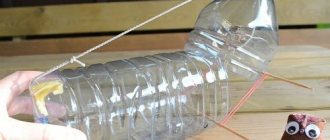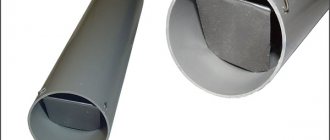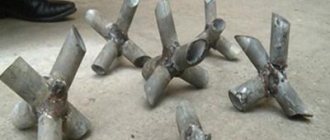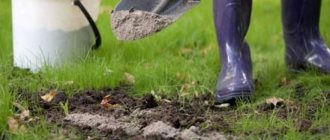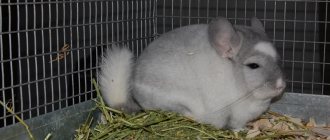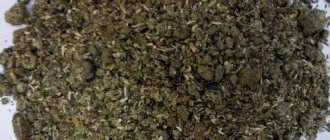With the arrival of autumn cold weather, mice begin to actively move from summer areas to human houses and apartments. Every year we have to contain the rodent infestation and look for more and more effective methods of control. There are only two ways to defeat the invasion of mice that have settled in your house or garage - get a cat or regularly install mousetraps. The bigger, the better. The easiest way is to make a mousetrap from a plastic bottle with your own hands. Costs are minimal, especially since there is plenty of material for traps. If you guess the design of a mousetrap made from a plastic bottle, then you can end the problem quickly enough.
Which trap to choose
At first glance, the easiest way is to buy a ready-made mousetrap or make a similar design with your own hands. But this is only at first glance. A mouse, like a rat, has considerable intelligence, learns quickly and remembers well how to bypass mousetraps. Therefore, it will be useful to periodically replace old plastic bottle mousetraps with new, more effective and efficient designs.
Most often, several of the most popular designs are used to combat domestic rodents:
- Petal mousetrap, it can be made in a couple of minutes, there is a considerable risk that the mouse may escape from the trap before it is reached;
- Falling mousetrap, if you make a structure from a plastic bottle exactly as described, then the effective operation of the device is guaranteed;
- A mousetrap is a rocking chair, the most difficult to make, but also the most effective. It can be done in several versions, the main thing is to follow the principle of operation. Such mousetraps can operate reliably for many years without any major complaints.
Advice! Don't underestimate the ability of mice to escape traps. You need to check traps as often as possible, since according to statistics, approximately half of the rodents successfully escape from the trap.
You can get an idea of the capabilities of mouse balancing act and understand how to make a mousetrap from a plastic bottle from the video
Other ways to kill mice
Not everyone wants to make their own mousetraps. If you want to choose simpler and less energy-consuming methods of fighting mice, then I advise you to read the portal materials using the links below.
Over the long history of fighting mice, people have collected the most effective methods. More details about them.
Safe and effective means of protecting your home from mice can grow on the site. Read more about their use.
A mousetrap is the first thing you think about when there is a mouse in the house. Types and applications of the tool in this article.
What you need to know before making a bottle mousetrap
First of all, you should not count on the absolute effectiveness of a mousetrap; even the most successful and effective, at first glance, trap can malfunction, so it will be useful to observe how the mouse falls into the trap and, most importantly, how it tries to get out of it. Such observations can be very useful when it comes time to make a new, more cunning mousetrap.
When planning the design of a mousetrap, there are three factors to consider:
- The plastic bottles from which the traps are made must be changed at least once a month;
- Poisons and toxic substances must not be used in mousetraps;
- The labor intensity of making a mousetrap from a plastic bottle should be minimal, otherwise this activity will quickly get boring.
The mouse has the ability to capture the most subtle odors. If a dozen mice are caught in a mousetrap, then odors with “signals” of panic will definitely remain on the plastic bottle. Such mousetraps should be thrown away without regret, and a new trap can be made to replace the old one.
The material of a plastic bottle does not pose a particular barrier for a rodent, so it is important not only to catch, but also to get the mouse out of the trap in time, before the animal simply gnaws a hole and runs away with the bait.
Harm and danger to humans
Mice in an apartment are not only an unpleasant and repulsive sight. Unwanted “neighbors” cause real harm to the property of home owners, and also pose a danger to their health:
Mice gnaw everything they can get their teeth into (furniture, partitions, baseboards), ruin wallpaper, and clothes. In search of food, they come not only to kitchens and places where human food supplies are stored. Mice are permanent inhabitants of dirty basements, garbage dumps, landfills, and garbage cans. These animals are carriers of pathogenic bacteria, microbes, and spreaders of life-threatening viral diseases.
On a note! Like all rodents, mice reproduce very quickly in comfortable conditions. One healthy female produces offspring of 15-20 mice per year. Already at three months they are full-fledged adults, beginning to reproduce independently. If urgent measures are not taken to exterminate rodents in the apartment, they will completely take over it in a very short time.
Options for the most successful mousetraps
All of the mousetrap designs below do not require special skills or tools and can be made, as they say, “on the knee” in a few minutes. To build a trap you use:
- Scotch tape and adhesive tape, nylon threads;
- Plastic bottles with a capacity of 2 and 3 liters;
- Scissors or stationery knife;
- Bait.
Advice! A piece of salted lard, fried seeds and a walnut kernel work reliably as bait.
Oddly enough, cheese or sausage are significantly inferior in effectiveness to lard; such bait quickly dries out and loses its attractiveness.
Make an effective bottle mousetrap in 60 seconds
A simple and quite effective mousetrap can be made from an ordinary three-liter plastic bottle. We use a nut kernel as bait. The full course on how to make a mousetrap from a plastic bottle is shown in the video
Initially, you will need to make a mount for the bait from two loops of nylon thread.
Using a utility knife, make a cut on the wall so that you get a petal covering a small window. The window size should be no more than 20 mm. Due to its rounded shape, the petal should easily bend inside the plastic bottle and not deviate outward, preventing the mouse from getting out of the trap.
We pierce the side walls of the bottle on both sides, stretch the thread with the bait and fix the suspension in a taut state using matches and tape.
The place for hanging the bait can be chosen at a height of at least 10-12 cm from the bottom, this is enough for an ordinary mouse, sometimes rodents demonstrate miracles of jumping ability, so the design of the trap can be supplemented with another bottle, which will catch everyone who covets the bait.
How to catch a mouse
Humanity has never been particularly friendly with mice. Due to the fact that rodents spread dangerous diseases, damaged crops and ruined people's lives in every possible way, people have always tried to get rid of them. For these purposes, various poisons were created, and simple and complex mechanisms were invented - mousetraps. But before you buy or make a mousetrap yourself, you need to determine the presence of rodents and their habitat.
Identifying the presence of mice in the house is quite simple. It is necessary to sprinkle suspicious areas with flour and leave them in this state overnight. If in the morning you find paw prints, then you can safely conclude that rodents have appeared. Also, if you find holes in the corners of the walls or mouse waste, this will be evidence that there are rodents in your house. This means it’s time to start catching them before they cause significant damage to property and health.
Deadly mousetraps
Such traps are designed to exterminate the mouse population. They show high efficiency and allow you to get rid of annoying animals in a short time. Such devices are of the following types:
Humane mousetraps
Despite the fact that mice are absolute pests and interfere with normal human life, not everyone is ready to take the lives of these creatures. In such cases, other types of mouse traps are used - harmless ones.
Such devices can be purchased at your local home improvement store, or you can make them yourself. The caught animal can be released in the nearest forest planting or released into the wild away from home.
In this article we will look at how to make several simple mousetraps from the most common and affordable material - plastic bottles.
The simplest mousetrap options
The simplest version of a mousetrap made from a plastic bottle is shown in the video
You can make a simple device with your own hands in a few seconds. You only need to cut off the neck and cut the edge of the remaining container with scissors in the form of triangular teeth, 30-35 mm long.
The jagged edges are folded into the bottle, and the bait is placed on the bottom of the trap. According to the creators' plan, the mouse gets inside the mousetrap, but will not be able to get out of it because of the teeth.
A more effective version of a mousetrap can be made from a plastic container according to the diagram below.
You need to cut off the top of the bottle, turn it over, remove the cap and put it back into the cut part. The result is a design reminiscent of an old non-spill inkwell.
It is recommended to treat the inside of the mousetrap with sunflower oil, and the installed upper part of the trap will need to be fixed with a stapler.
A good falling mousetrap can be made from an ordinary plastic bottle with a window cut out in the neck area. Bait is placed at the bottom of the bottle, and the trap itself is tied with a cord around the neck and placed on the table.
To trigger the mousetrap, it is placed on the edge so that the bottom part with the bait is behind the edge of the tabletop. The mouse, having climbed into the bottle, upsets the balance, which leads to the container tipping over and hanging on the cord.
Getting out of the mouse container is quite difficult. It will be necessary to remove it from the trap in time before the cat steals it along with the trap.
Reasons for the appearance of mice in the apartment
Mousetrap
The main factor explaining the appearance of mice in a living space is food. Food supplies in the form of cereals in bags are often stored in basements and barns. If an animal finds such a tasty spot, it will definitely try to take some grains with it. The rodent will leave characteristic marks on the bags.
Important! The onset of cold weather is considered a particularly popular time for mice to move into the house. In the fall, rodents are forced to go in search of a warm shelter, and the most favorite place is considered to be a home with unsanitary conditions. Clutter, trash and food left uncovered are attractive breeding grounds for pests.
Clutter, trash, and food left uncovered are attractive breeding grounds for pests.
The presence of nuts and seeds in the house that are not tightly packed can help in getting mice. The products emit an aroma that is well captured by the sensitive sense of smell of animals.
If there are large cracks and holes in the walls or floor, then mice can easily crawl along them into the house from the street or from neighbors. It is recommended to carry out repairs in the house and tightly close all holes in surfaces.
How to make a mousetrap - a rocking chair
The most perfect mouse trap can be made using the principle of a swing or a pendulum. The principle of operation of the mousetrap is in many ways similar to the previous version of the trap, the only difference being that the bottle does not tip over from the table, but tilts under the weight of the mouse, blocking the exit from the trap.
The typical design of the device is shown in the photo. The principle of operation can be seen in more detail in the video.
In order to make a trap, you will need a 1.5 liter bottle, preferably with a long and narrow neck. Since the mousetrap must swing freely under the weight of the animal, you will first need to determine the line on which the center of gravity is located. To do this, you can place an ordinary faceted pencil on the table and a container on it. Moving the bottle left and right, we find the equilibrium position and mark the line with a marker.
According to the plan, the bottle should swing on an axis of rotation, which can be used as a piece of flat steel wire or a bicycle spoke. On the balance line, mark the midpoint and use an awl to punch two holes through which we pass the axis of rotation.
A plastic container with a steel axis will need to be installed on a stand. To do this, you can use a small piece of board, 35-40 cm long. We nail two wooden blocks of the same size to the board, on which the axis of rotation will rest. When rocking, the neck of the bottle should lower and rise at least 20-30 mm.
All that remains is to manufacture and install the locking block. The height of the block is selected such that, in a raised position, the lower edge of the hole for the plug is at the same level as the upper edge of the wooden block. This way, the mouse can easily climb up the bar into the trap. Under the weight of the rodent, the bottle will turn and close the entrance to the container. It is clear that the weight of the bait should be half the weight of the rodent, optimally 3-5 g, no more.
Details
What you need to know before making a mousetrap from a bottle
At the very beginning, keep in mind that you should not count on the full effectiveness of the mouse trap; even the most successful and effective mouse trap at first glance can fail, and therefore it will be useful to observe how the mouse falls into the trap, and most importantly, how it tries to get out of it. Such observations may come in handy when the time comes to make a new and more improved mousetrap. When planning a mousetrap structure, the following 3 circumstances must be taken into account:
The PET bottles from which the traps are made must be changed at least once a month.- In no case should toxic substances or poisons be used in mouse traps.
- The labor intensity of creating a mousetrap from a PET bottle should be small, otherwise such an activity will quickly get boring.
A mouse has the ability to capture the most subtle aromas, and if about 10 mice are caught in a mousetrap, then aromas with “signals” of panic will always remain on the PET bottle. These mousetraps need to be thrown away without sadness, and a brand new trap can be made to replace the old one. The material of the PET bottle does not represent a particular barrier for the rodent, and therefore it is important not only to catch it, but also to get the mouse out of the trap in time, before the animal simply gnaws the hole and runs away, taking the bait.
Options for the most successful mousetraps
The designs below do not require any special skills or tools, and they can be done, as they say, “on the knee” in a couple of minutes. To create a mousetrap from a plastic bottle, use:
- Bait.
- Stationery knife or scissors.
- PET bottles with a capacity of 2 and 3 liters.
- Adhesive tape and tape, nylon threads.
Helpful advice! A piece of salted lard, fried seeds and a walnut kernel work reliably as bait.
No matter how strange it may be, sausage or cheese is much less effective than lard, and this bait quickly dries out and loses its beauty. A simple and very effective mousetrap can be made from a simple three-liter plastic bottle. Use a nut kernel as bait, and the full process of how to make a mousetrap from a PET bottle is given in the video. Initially, you will need to make a mount for the bait from a pair of loops of nylon thread. Using a stationery knife, you need to make a cut on the surface of the wall so that you get a petal that covers a small window. The dimensions of the “window” should be no more than 2 cm, and thanks to its rounded shape, the petal should easily bend inward into the plastic bottle and not deviate outward, preventing the rodent from getting out of the trap.
Pierce the side walls of the bottles on both sides, stretch the thread with the bait and fix the suspension in a taut state with tape and matches. The place where the bait will be suspended can be chosen at a height of no more than 12 cm from the bottom element, and this is enough for a simple mouse, and sometimes rodents show miracles of jumping ability, and for this reason, the design of the trap can be supplemented with another bottle, which will catch everything, who will covet a piece of delicious food left behind?
The simplest types of mousetraps
The simplest version of a mousetrap made from a PET bottle is shown in the video. You can create a simple device with your own hands in a couple of minutes. You just need to cut off the neck, and cut the edge of the remaining container using scissors into jagged teeth shaped like a triangle with a length of 3 to 3.5 cm. The jagged edges will bend inside the bottle, and the bait will be placed on the trap bottom. As planned by the manufacturers, the mouse will fall inside the mousetrap, but it will not be possible to get out of it due to the teeth. A more effective type of mousetrap would be one that can be made from a plastic container according to the diagram presented below. You need to cut off the top part of the bottle, turn it over, remove the cap and mount it back into the cut element. This will result in a design that strongly resembles the USSR non-spill inkwell in design.
It is recommended to treat the internal mousetrap part with sunflower oil, and installing the upper part of the trap must be secured with a stapler. An excellent falling-type mousetrap can be made from a simple plastic bottle with a cut-out window in the neck area. Place bait (lard, nuts) on the bottom of the bottle, tie the trap itself with a cord around the neck and place it on the table. In order for the mousetrap to work, it is placed on the edge so that part of the bottom with the bait is behind the edge of the tabletop. A mouse entering the bottle will ruin the balancing, and this will cause the container to tip over and hang on the cord. It is very difficult to get out of the mouse container. You need to remove it from the trap in time, before the cat throws it off with the trap.
How to make a rocking mousetrap
The best trap for a mouse can be made using the principle of a pendulum or swing. The principle of operation of such a mousetrap is in many ways similar to the previous version of the trap, but the only difference is that the bottle will not tip over from the table, but will tilt under the weight of the rodent, blocking the exit from the trap. A typical design is shown in the photo. The principle of operation can be seen in more detail in the video. In order to make a mousetrap from a plastic bottle with your own hands with a capacity of 1.5 liters, preferably with a narrow and long neck.
Since the device must swing freely under the weight of the animal, it is necessary to determine in advance the line on which the center of gravity will be located. To do this, you need to place a simple faceted pencil on the table, and also a container on it. Moving the bottle left and right, find the equilibrium position, and also mark the line with a marker. As planned, the bottle should swing on an axis of rotation, and a piece of flat steel wire or a bicycle spoke can be used as it. On the balance line, mark the midpoint and use an awl to punch a couple of holes through which the axis of rotation will pass.
A plastic container with a steel axis needs to be installed on a stand, and for this you can use a small piece of board with a length of 0.4 meters. Nail a couple of wooden blocks of the same size to the board, on which the axis of rotation will rest. When swinging, the neck of the bottle should lower and rise at least 0.2-0.3 meters. All that remains is to make and install the locking block. Its height must be chosen such that, in a raised position, the lower edge of the plug hole is flush with the upper edge of the wooden block. So, the mouse can easily climb up the bar into the trap, and under the weight of the mouse the bottle will turn and close the entrance to the PET container. Naturally, the mass of the bait should be 2 times less than the weight of the mouse, ideally from 3 to 5 grams, no more.
Trap made from a bucket and a plastic bottle
The oldest and also proven design for catching mice can be made from a bottle with a capacity of 0.5 liters, a galvanized bucket and wire. First you need to drill a hole in the bottom and cap of the bottle that is equal to the diameter of the wire. The latter will play the role of an axis for rotation, and therefore the plastic container should rotate effortlessly and freely.
The length of the wire is chosen 6 cm longer than the diameter of the bucket. For a bottle that is attached to a wire, additionally put on a tin lid, which is used for preservation. Tie a bait on the side of the bottle to the lid and install the entire structure on the bucket.
You can attach a wooden plank or plank to it to make it easier for the animals to rise to the top. If there are a lot of rodents in the basement or garage, then the inside of the bucket needs to be wiped with oil or filled with water to create a surface so that it is as slippery as possible. Up to 10 mice can fall into the trap during the night, and then you will need to take measures to prevent the animals from escaping from the trap.
The device works very simply, and the mouse, trying to get to the bait, will come out onto the rotating bottle and fall down. The slippery surface of the plastic makes it almost impossible to get a grip. Unlike other designs, such a mousetrap can be left overnight without fear that rodents will damage the trap or be able to escape from it. Instead of a bottle, you can use any object with a smooth surface and a large diameter. You can mount a ruler, a piece of polypropylene water pipe, and even a piece of glass. Wood and untreated metal will perform even worse.
Trap made from a plastic bottle and bucket
The oldest and most proven mousetrap can be made from a half-liter bottle, wire and a galvanized bucket. Initially, you will need to drill a hole equal to the diameter of the wire in the bottom and in the cap of the bottle. The latter plays the role of an axis of rotation, so the plastic container should rotate freely and effortlessly. The length of the wire is chosen 5-7 cm larger than the diameter of the bucket.
The bottle, dressed on a wire, is additionally fitted with a tin lid used for preservation. From the side of the bottle, a bait is tied to the lid and the entire structure is installed on the bucket. You can attach a wooden plank or plank to the bucket to make it easier for the animals to climb up. If there are a lot of mice in the garage or basement, then the inside of the bucket must be wiped with oil or filled with water to make the surface as slippery as possible. Up to ten animals can be caught in a trap during the night, so measures must be taken to prevent mice from escaping from the trap.
The mousetrap works quite simply. The mouse, trying to get to the bait, steps onto the rotating bottle and falls down. Due to the slippery surface of the plastic, it is almost impossible to catch on the bottle. Unlike previous designs, such a mousetrap can be freely left overnight without fear that rodents will damage the trap or be able to escape from it.
Instead of a bottle, you can use any object with a large diameter and a smooth surface. You can install a ruler, a piece of polypropylene water pipe, and even a piece of glass. Wood and untreated metal work the worst.
Harm from a mouse infestation
Mice in the garden are a problem for gardeners. They spoil the harvest, stocks of vegetables and cereals. In the house they leave traces of vital activity, spoil clothes and leave an unpleasant odor. Also, what is most dangerous, they are carriers of diseases.
DIY electronic mousetrap: diagram, instructions for use
The principle of operation of such a mousetrap is quite simple. There is a motion sensor on the mousetrap. As soon as it is triggered, a low current discharge is applied and the animal is killed. People who have a little knowledge of electronics can make such a device. Instructions for making an electronic mousetrap can be found in the video. Several electronic circuits for assembling a mousetrap are presented below.
Do-it-yourself electronic mousetrap: diagram, instructions for use Do-it-yourself electronic mousetrap: diagram, instructions for use



